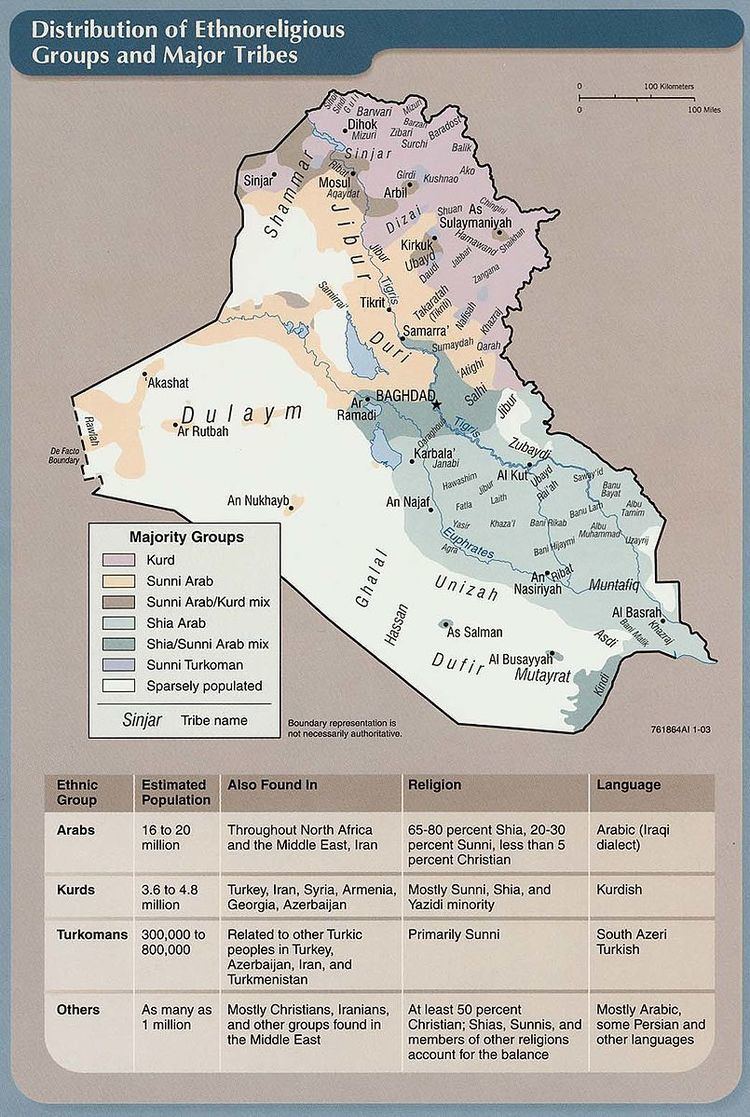 | ||
This article is about the demographic features of the population of Iraq, including population density, ethnicity, education level, health of the populace, economic status, religious affiliations and other aspects of the population.
Contents
- Map of Iraq
- Background
- Population
- UN estimates
- Structure of the population
- Ethnic and religious groups
- Languages
- Religions
- Demographic statistics
- Age structure
- Ethnic groups
- Median age
- Population growth rate
- Crude birth rate
- Crude death rate
- Total fertility rate
- Net migration rate
- Urbanization
- Sex ratio
- Maternal mortality rate
- Infant mortality rate
- Life expectancy at birth
- Contraceptive prevalence rate
- Health expenditures
- Physicians density
- Hospital bed density
- Obesity adult prevalence rate
- Children under the age of 5 years underweight
- Nationality
- Literacy
- References
Map of Iraq
The population is estimated to be 36,585,692 as of July 2014, with most of the population being Arab (80-85%), followed by Kurds (10-15%) and others (5%). 99% are Muslims, 0.8% Christians and the rest belong to other minorities.
Background
Iraq is the region known outside the Islamic world as Mesopotamia. The population estimate in 1920 was 3 million. The ruins of Ur, Babylon and other ancient cities are situated in Iraq, as is the legendary location of the Garden of Eden. Almost 75% of Iraq's population lives in the flat, alluvial plain stretching southeast from Tikrit to the Persian Gulf. The Tigris and the Euphrates carry about 70 million cubic meters of silt annually from this plain down to the delta. The water from these two great rivers, and the fertility of the soil in the alluvial plain and the delta, allowed early agriculture to sustain a stable population as far back as the 7th millennium BC.
Population
32,585,692 (July 2014 estimate), up from 31,234,000 (April 2009 IMF estimate)UN estimates
Births and deaths
Structure of the population
Structure of the population (01.07.2013) (Estimates) :
Ethnic and religious groups
Iraq's dominant ethnic group are the Iraqi or Mesopotamian Arabs, who account for around three-quarters of the population. They are a fusion of old Mesopotamian, Arabian, Iranian, and other populations, who now speak Mesopotamian Arabic.
Iraqi Arabs (including Palestinians, Marsh Arabs, Bedouins and other Arab subgroups): 72-75%, Kurds (including Feylis, Yazidis, Shabaks and Kaka'is): 20-22%, Turkmen: 2%, Assyrians: 2%, other: 1% (Armenians, Circassians, Persians, Mandaeans/Sabians, Bahá'ís and Afro-Iraqis and Doms).
Kurds have one of the highest birth rates of any group in Iraq and the middle east.
Languages
Arabic and Kurdish is the official two language of Iraq. Arabic is spoken or understood by almost all the population.
Kurdish is the largest second language and has regional language status in Iraqi Kurdistan. Aramaic, once spoken by the whole country, is now only spoken by the Assyrian minority.
Azerbaijani is spoken in pockets of northern Iraq and Persian is spoken in pockets of southern Iraq. Numerous languages of the Caucasus are also spoken by minorities across the country.
Religions
99% of Iraqis follow Islam: 65-79% Shia and 21-35% Sunni. 1% of these describe themselves as "Just a Muslim". According to the CIA Factbook, Shias make up 65% of population, while Sunnis 32%. Christianity accounts for 0.8%, and the rest practice Mandaeism, Yazidism and other religions.
While there has been voluntary relocation of many Christian families to northern Iraq, recent reporting indicates that the overall Christian population may have dropped by as much as 50 percent since the fall of Saddam Hussein in 2003, with many fleeing to Syria, Jordan, and Lebanon (2010 estimate). The percentage of Christians has fallen from 6% in 1991 or 1.5 million to about one third of this, due to massive exodus - two-thirds of Assyrian Christians have fled to other countries in the Middle East, Europe, United States and Canada.
Nearly all Iraqi Kurds are Sunni Muslims. A survey in Iraq concluded that "68% of Kurds in Iraq identified themselves as Sunnis and only 28% identified as Shias". The religious differences between Sunni Arabs and Sunni Kurds are small. While 89 percent of Shia Arabs belief that visiting the shrines of saints is acceptable, 71 percent of Sunni Arabs did and 59 percent of Sunni Kurds support this practice. About 94 percent of the population in Iraqi Kurdistan is Muslim
Demographic statistics
The following demographic statistics are from the CIA World Factbook, unless otherwise indicated.=
